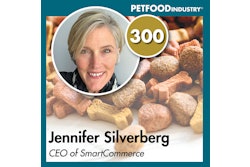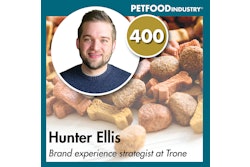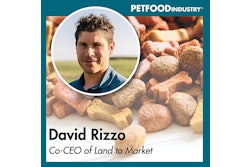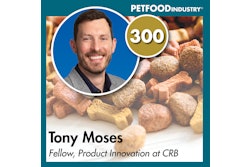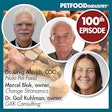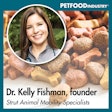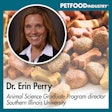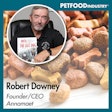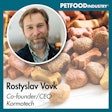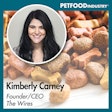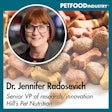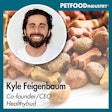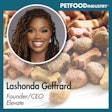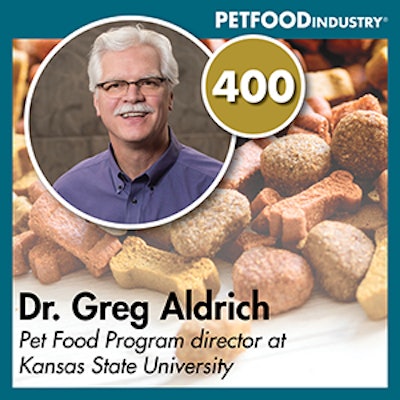
If you've ever wondered how a circular economy works, and in particular what it might look like in the pet food industry, this is the episode for you. Kansas State University Pet Food Program Director Dr. Greg Aldrich and I discussed where pet food is in terms of satisfying the tenets of a circular economy, where there's still work to be done, and why the finish line must be ever-moving as we strive for continuous improvement in our corner of the consumer goods space.
The below transcript is from Episode 27 of the Trending: Pet Food podcast, where I spoke with Associate Professor and Director of the Pet Food Program at Kansas State University Dr. Greg Aldrich about the circular economy and the pet food industry. You can find the episode at www.PetfoodIndustry.com/trending-pet-food-podcast, on SoundCloud or on your favorite podcast platform. This episode originally aired on February 1, 2023.
(We want to thank AFB international for sponsoring this podcast. AFB is the premier supplier of palatants to pet food companies worldwide, offering off-the-shelf and custom solutions that make pet food, treats and supplements taste great.)
Lindsay Beaton – Editor, Petfood Industry magazine and Host, Trending: Pet Food podcast
Hello, and welcome to Trending: Pet Food, the industry podcast where we cover all the latest hot topics and trends in pet food. I'm your host and Editor of Petfood Industry magazine, Lindsay Beaton, and I'm here today with Dr. Greg Aldrich, associate professor and director of the Pet Food Program at Kansas State University. Hi Greg, and welcome!
Dr. Greg Aldrich – Associate Professor and Pet Food Program Director, Kansas State University
Hello, Lindsay. Thanks for the invite.
[IN-EPISODE EDITOR’S NOTE]
Beaton: Hello, podcast listeners. This is post-recording Editor Lindsay and I'm speaking to you mid-edit to clarify the timing of the episode you're about to listen to. As of when this episode goes live on February 1, 2023, Dr. Greg Aldrich is the newly appointed chief operating officer for premium pet food company Nulo. But when we recorded this episode together in December 2022, he was still an associate professor and director of the Pet Food Program at Kansas State University. As a result, our discussion is through that lens — just something to keep in mind!
As for the rest of his bio, he received his Ph.D. in Nutrition from the University of Illinois in 1995. He has been an active industry product developer and more recently added academic research since 2012. In this capacity, his focus was on characterizing the impact of pet food processing on the nutritional value of ingredients. As a faculty member he supervised 29 M.S. and Ph.D. students and post-doctoral researchers. He's authored 10 book chapters, 83 peer-reviewed manuscripts, and delivered 319 abstracts and invited presentations. Dr. Aldrich is a member of the American Society of Animal Science, International Association of Food Protection, and the American Academy of Veterinary Nutrition, and serves on the editorial board for Animal Feed Science & Technology. He also just wrapped up a long-term position as a monthly columnist for Petfood Industry magazine, covering over 222 topics, and in 2019 he received the Corbin Companion Animal Biology Award from the American Society of Animal Science.
Okay, now that we're all clear on that I'm passing this back to Host Lindsay — enjoy the episode!
[END IN-EPISODE EDITOR’S NOTE]
Beaton: Greg's extensive expertise in all things pet food, nutrition and processing, as well as the pet food space overall, is why I've brought him on today to answer this question: Where does the idea of a circular economy fit in the pet food space?
Now, there's a lot going on in the pet food industry right now, and a lot of change on the horizon. And the idea of a circular economy in terms of sustainability, which is a huge trend in the space right now, has started to become a bit of a conversation in various parts of pet food. I want to start off with a little bit of background about a circular economy. What would this idea look like as it pertains to the pet food industry?
Aldrich: Well, Lindsay, let's start with just defining what a circular economy is. In a way we kind of have to back into it; our traditional thoughts and concepts of an economy are that we have some sort of raw material that we're producing, and then we convert that into a finished good that is then consumed by the public writ large. And then what we don't use we throw away. And so it's a one-way ticket from production through to waste, and that could be landfill or it could be just discarded down the sink. But the bottom line is, is that there's always a big portion of that material that we spent time and energy producing that gets thrown away.
With a circular economy, the idea is that there is a world without waste, we don't waste anything. And so as we're growing crops, we're producing livestock or fish or other inputs from the foods industry, that we go through this process of raw material production through conversion or production of food products, through use, and that any of the secondary metabolites, the co-product streams, the packaging or anything else, gets reconverted into something that we can use. It might be back into food or it might be into an industrial process, but the idea is that we're not losing that material, we're capturing as much as possible so that we're not polluting the environment. We're not blowing too much CO2 into the air. The whole idea is “waste not, want not.” And the “bio” part of that is we're applying it not just to everything; it's mostly the biological materials that we would consider for food production.
So how does that appear for Pet? Well, pet was sustainable before sustainability was cool, right? We were using byproducts and co-products and secondary products of food processing long before this spark ever started to emerge that we should be protecting our planet. But the opportunity for pet food is this: That we get even better at what we've been doing and we continue to foster the process of keeping waste out of the landfills, especially as we think about things like packaging, or we continue through improvements so that we are decreasing our impact on the planet and we get to be a bigger part of the solution. I don't think we've taken credit for it in pet food, and it's an opportunity for us to get more credit than what we have in the past.
Beaton: Well, it's clear why this idea is taking up space in the pet food conversation right now, because of the sustainability trend and the idea of completing that loop of waste in something that it already seems like the pet food industry has been doing in part for a while now in terms of like you said, using byproducts and ensuring that there is less waste at the end of a production pipeline. What could actively enacting the circular economy idea accomplish in terms of what the pet food industry currently needs, both internally as a business that needs to become sustainable and then in terms of meeting the trends that pet owners are looking for right now?
Aldrich: The list is long, but I'll start — I want to make sure that we understand that it's not a singular component that helps us be either sustainable or circular, it's a combination of things. It's everything from the animal side of the equation, making sure that the foods we provide our animals are nourishing them to their necessary degree but not over-nutrition. So obese animals is actually a negative associated to a circular bioeconomy. We’re overfeeding, right? If we are designing products that cause great amounts of elimination products, then those are pet waste products that have to go either into your sewage system or they get landfilled, right, so the animal is part of the equation. Product design is part of the equation, whether or not we utilize rare and limited supplies of ingredients, or we're competing in on valuable food ingredients with the human food sector. It even includes the distance of product has to travel. So if I'm purchasing rare ingredients from halfway across the world, there's a lot of shipping and processing that had to go into it.
And so we just have to chip away at each little bit of those sorts of things: The manufacturing process, are we producing these in the most energy-efficient manners and down at the very end of its lifecycle in regards to packaging? Are we using the lowest-cost (in terms of environmental cost) packaging styles that are going to get the product in its most pristine manner to the pet without causing great amounts of waste that we have to go to landfill with? There's just a myriad of things that we can be looking at in Pet that will answer some of those questions.
Why is that important? Well, we've been doing some of those things, but it's at this stage [where] it's an opportunity for us in the production of pet food to have a position that we can describe to the industry. It's important for us to be able to retain the right kinds of ingredients so we have them for the long-term. It's all of those factors; more recently, the companies that are entering into this area, it's a new avenue to promote their product to attract customers. So I see it having an impact across the board.
Beaton: In the whole pet food industry process, where are we closest to already being where we need to be to accomplish the full circular economy model, and which part of pet food production do you think is going to need to make the biggest amount of change to make it fall in line with the model?
Aldrich: I would tell you that our traditional foods were pretty close to that baseline already because we were using animal byproducts as protein sources. They weren't feeding excessive levels of protein, which is one of the most expensive ecological components, and they were using large bags and they were mostly paper-based so they were biodegradable. And so the idea is, is that we were kind of there. We could still improve in those areas. But as we've emerged in the last dozen years or so, two dozen years, with a continuing fragmentation and differentiation in the market, it's all important for establishing brands.
But at some point, as we get more and more “elitism” built into the system, we're starting to get into products that are — fresh is an example — delivered to your home every day. That last mile is where we start to invoke some additional cost from an ecological standpoint to provide the nourishment of the animal. We got ultra-high-protein formulas for an everyday couch potato dog; we're starting to unbalanced this notion of being in that circular bioeconomy. I'm not suggesting that any of those are evil, what I'm just simply saying is, is that we have to understand that there may be some trade-offs. And there may be some opportunities for those organizations that have those product classes to continue to work on their carbon footprint and improve the impact they have on the environment, the lifecycle analysis, the waste materials, and those sorts of things. Because if we're going with a very high-end product, it's fresh food delivered to your home, chances are the fecal elimination of that animal is less. So there's, again, some balance here; we need to start to capture some of that information and demonstrate that we're moving in the right direction.
Beaton: I think that's interesting, because a lot of times it's those “higher-end” brands, the premium and even the superpremium, the fresh, the freeze-dried, those are the companies that are really speaking to the focus of sustainability. So it's interesting that it sounds like they might have some additional challenges in terms of closing this loop that traditional kibble is a lot closer to closing than these other ones. Does that make sense? Or is it just that every type of pet food has different types of challenges to reach the end goal, but it's achievable for everybody?
Aldrich: Bottom line here, Lindsey, is I think that every product that we produce is going to have some burden that it needs to address, and some are going to be more efficient than others. And what we have is — maybe I'll call it a horse race, and everybody's in the race and everybody can improve. So it's not like that we're going to a destination and a company has zero and they're the best, it's that all of them have an opportunity for improvement. It's not a destination, it’s a journey. It's a continuous improvement process. And we've got to start to quantify it. If companies decide that they want to give themselves scores, that's great, because that creates a different sort of currency for competition than just price, right? Or just simple nutrient composition. It gives us another layer here that we can start to have a different discussion, a different narrative, a different point of view. And I think it's going to improve products for everybody.
Beaton: Is a circular economy model the preferred answer to everything that's going on right now in the industry in terms of sustainability and building the future of the industry? Are there other models that we could evolve into as well? Or is this really the number one goal we should be aspiring to, in your opinion?
Aldrich: My opinion is that's the number one goal, is waste not, want not, it’s a world without waste. It's the idea that if we're going to expend energy and resources and fertilizer, carbon, oxygen, carbon dioxide, all of those elements that go in along with solar radiation, and we're going to grow things from the ground, and we're going to rear animals and fish from the sea, then, you know, we want to make sure that whatever we do there, there's no wasted effort. And it comes down to the end of the process. We have this beautiful system, this ecosystem that we built in North America and in Europe, and it will come along in other regions of the world, as we continue to mature that there's always going to be little side streams of material that are going to be secondary to the original intent. And if we can figure out ways to capture that carbon, to capture that nitrogen in a way that we can reintroduce it — call it upcycle, call it recycle, call it whatever — if we can capture all that and reuse it in an efficient way, then that's going to decrease the requirement for food and other consumer products across the globe. And we can continue to have the carrying capacity that we need. And pet food needs to be a part of that.
So your original question was, is the circular bioeconomy the right model? Are there other models? You know, there's probably other models out there. I've not tried to delve into what the deviations are over the last 30 or 40 years. I would tell you that this whole idea that we're captive in this rock called Earth and this terrarium, and we've only got one circle to work with, is kind of where we are. We either recapture those materials and use them effectively, or we dump them and hope that something good comes of them. But we've put a lot of energy into it. And I would hope that we could capture some of that out of it, pet can be a part of that.
Beaton: With the way the industry is operating right now and with the resources it has, do you think this is an achievable goal? And if so, what do you think the timeline looks like?
Aldrich: So first off, I don't think it's a goal, I think it's a continuous improvement, and every company needs to start to adopt some thought process around it. Almost all of them I talked to are starting to at least communicate about sustainability. Some are looking at it as sort of greenwashing and using it as marketing. Others are taking it sincerely and implementing some steps. All steps are beneficial. They're continuous improvements — increments, little bitty steps, every week, every month, every year, and eventually you get more efficient. Whether or not we get to a plateau where improvement can't be made any more, I don't know, but I would tell you that we're going to get better; the market is going to help us get better because I think consumers are tuned in. And so this is probably the bigger thing, this is the biggest shift in our thought processes, Lindsay, in the last 20 years, and that is consumers: The younger generation is becoming more and more aware of this whole concept; they're going to start to demand in the market companies that are communicating that back to them. And then I think we're going to have substantial improvements, then we're going to have metrics. Not everybody's going to use the same metric; I know at least one group that looks at four different approaches. And any company can pick any one of those four to go down a sustainability channel, there's probably six or eight or 10 different components, that any pet food company could go down that path and start to make a case for why their product is better for the environment, better for the circular bioeconomy, decreases waste, improves sustainability, those sorts of things. So I'm looking at this is a process of getting to better over the next 10 years, rather than worrying about getting to a place.
Beaton: If you listen to the show at all, you know that I'm a big fan of discussing education — consumer education, industry education, you name it. So I want to ask you, because obviously you're the perfect person to ask about education, what kind of education on the industry side needs to happen to get everybody on board with this? And then what kind of role will education of the consumer play? How can they help the industry help itself?
Aldrich: So from the industry side — and I'm going to pick on our friends in regulatory affairs, both from the AAFCO and federal government, FDA, as well as the companies — at some point we've got to decide that we're going to improve the nomenclature and description of ingredients so that they don't vilify and create negatives associated with their utility. And then I'm going to pick on the term “byproducts.” Byproducts is a vilified term by consumers and activist groups, but in essence a byproduct is just secondary to its intended or primary purpose. And we need to make those positives rather than negative. So let's get the language fixed. And I think there are some opportunities to educate and negotiate with those entities so that the terminology describes what the ingredient is, and it doesn't create a negative persona or perception. And for too many years we've had debates over this and it's just fallen on deaf ears; it's time to get right with where this needs to go for the bioeconomy, rather than worrying about whether or not it's an old term that's always been there. Let's fix that. That's on the industry and regulatory side.
On the consumer side, we need to get them educated, trained, communicated, opened up to the notion of upcycling and recycling and capturing secondary products for our pets. And I'm talking about things like byproducts; its name would apply to things like liver: Chicken liver would be a fantastic ingredient for my pet, but it's called a byproduct because of the regulatory, go back to plan A, right? So we've got to start to educate people on what these terms mean and what the value is associated with their pet and where their pet fits in the economy. And at some point, the pet owner needs to be the one helping demand that these products that they're feeding to their animals provide better for not just the nutrition and their pocketbook, but for their community. And that's kind of what we're talking about here, is the community.
Beaton: How do you get everybody on board with that? Because I feel like it's really gotten baked into the language at this point and the perception of things. So how do we either go back or move forward so that people can see it in the appropriate light?
Aldrich: You're absolutely correct. Those terminologies are there and we've been fighting them, and I quit fighting those languages or those terms. I try to do — and my students get tired of hearing me say this — change the narrative, change the narrative, don't try to get in defensive mode and try to refute somebody's argument against something. Identify what the positives are, you know, accentuate the positive and ignore the negatives. And the idea here is that if we can change the narrative, if we can show the good and the valuable and the beneficial, then it may change a few hearts and minds. We're never going to change them all though; it's really about mass action. You know, the pet food industry is selling 8.5–9 million metric tons of pet food every year here in the U.S., and it's a, what, a US$40–$45 billion dollar industry, you know? If we can start to shift a portion of it, we're going to have a pretty substantial change; it's a big mast, it's a big ship. So if we can start to steer it just ever so slightly away from where it's been, and get better at these things, then it's going to improve.
Beaton: Before we wrap up, I want to dive into that more. Because the future focus seems like it's going to be a very important part of making all of this happen, just people having a vision of what the future could look like in mind and continuous improvement in going towards that future. And then once you get there, then move the ball forward some more, and move it forward more, and just continually keep pushing, no stagnation. Where do you think the industry is right at this moment? And then where do you see the industry going? Do you feel like we're on a reasonable timeline of improvement right now? Is it going too slowly? Is it moving fairly quickly? I want to get a sense of where we're at and how we're moving. Are we at a snail's pace here, or are we being reasonable compared to other industries?
Aldrich: So, I'm going to pick on people. I'm going to use comparisons to resolve that or to come up with a framework for comparison, where we are. And I would tell you that we're 5x better than the human food industry today. That doesn't mean we're at the end and it doesn't mean that we have accomplished everything. But we're far and away better off than where the human foods industry is collectively. We're making them look good, because we're taking a lot of their co-product streams today and converting them into products for pets. And a lot of folks are accepting of those products. And so I think we're in a pretty good spot. The continuous improvement areas that I think we got to see here, Lindsay, are going to be probably in that last mile, how we get product from retail or distribution to our homes. I think there's some huge opportunities for us to do improvement in packaging, even product design. I think we've got to get better at nutrition, and it doesn't mean more nutrition, it means better nutrition — better in regards to, you know, there's not a lot of funding for nutrition research for animals, [so] we may be over nutrition or we may be under, we've just got to do better. And so those continuous progresses, I think, puts us that if this is 100-mile journey, I think pet food to get to that next step is at mile 68. We’re two-thirds of the way, but we still got another third to go.
Beaton: That feels pretty optimistic to me. I feel like that's further than I expected you to say!
Aldrich: I understand that. But remember, we're gonna get to the mile marker 100 and we're gonna move the mile marker again, right? We're gonna get better, continuous improvement. And one of those things that we're going to do is continue to look at all of these different technologies. You know, I'm talking about things like insect proteins and biodegradable or consumable packaging, using waste streams from the slaughter industry like blood and converting those into yeast products that we then feed back into pets. All of those things are going to make us move that needle even further. It's going to continue to support the human foods industry. I've seen reports where people are trying to point a finger at Pet as being a net negative to the sustainability through carbon footprints, and I think they're full of beans. We're actually in pretty good shape. We're out ahead of most, but that doesn't mean that we can't continue to improve. And by communicating and educating about those strategies with people and pets, I think the message will actually translate over to people in their own food. So it's a win-win.
Beaton: Let's say a company is listening to this and they want to do some kind of analysis on where they're at within their own respective business in terms of contributing to where we eventually want to be as an industry. With the circular economy model, how would a company go about building an analysis of their business, to figure out where they're at and what next steps they need to take?
Aldrich: So first of all, most people will look at doing a lifecycle analysis, so that start-to-finish cycle of that product, or you can measure things like carbon footprint, CO2 production, from start to finish. And several industries have taken that on, and usually get some help from some engineering folks to help with that computation; there's some assumptions you make along the way. So the industry or a company can certainly go out there and start that process. There are a few groups out there, like the Pet Sustainability Coalition, that can help you with capturing bits and pieces of that information. Several universities may have engineering groups that would help with those pieces. So there's a way to start in the process of looking at carbon footprint, you can look at waste, you can look at upcycling and raw materials, you can work with your ingredient suppliers, look at opportunities there, packaging suppliers … those are a couple of the places I'd be looking to start the process.
It's a big project, this is a big area. And I would encourage people to wade their way into it; don't get discouraged by its size or some of the vernacular, just wade into it. And then eventually it will start to become a part of the culture of your organization. You won't understand it completely overnight. I feel like a student in this business, and so I'm going to continue to learn.
Beaton: I think that's a great point to make. And it's one of the big reasons I wanted to have you on to discuss this, because it is a huge topic. It involves the entirety of the industry, which is why I think it feels so big. Anybody listening to this podcast is involved. Anybody who's involved in pet food is involved. And that makes it a massive project with a ton of moving parts. And like you said, there really is no end; it is continuous improvement. But we're already on the path and it's time to be more intentional about it, right, so that we're not losing the way and we know where we all need to go as an industry. And we're moving forward on the path with whatever respective portions of the industry we're involved in. So I really appreciate you being on today to try to break down some of this with me so that people know even where to start, because I think we are all learning about this in a way that we even five years ago were not focused on.
That is it for today. But before we go, I want to do a little plug: Where can people find you, and where can people find more information about K-State's Pet Food Program?
Aldrich: First, thank you for the invitation to visit on this topic. We're going to continue to pursue it at the university level in our research for quite some time. We think it's got a lot of legs under it for us as a research and a place to train students. For us at K State there's a specific pet food website: www.k-state.edu/pet-food. So if you go out and just Google (or whatever search engine you use) “pet food at K-State” chances are you'll find us.
Beaton: Excellent. That is it for this episode of Trending: Pet Food. You can find us on www.PetfoodIndustry.com, SoundCloud or your favorite podcast platform. You can also follow us on Instagram @trendingpetfoodpodcast. And if you want to chat or have any feedback, I'd love to hear from you. Feel free to drop me an email: [email protected]. And of course, thanks again to our sponsor AFB International, the premier supplier of palatants to pet food companies worldwide offering off-the-shelf and custom solutions that make pet food, treats and supplements taste great. Once again, I'm Lindsay Beaton, your host and Editor of Petfood Industry magazine, and we'll talk to you next time. Thanks for tuning in!


